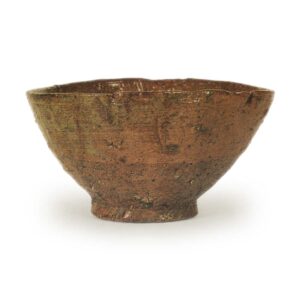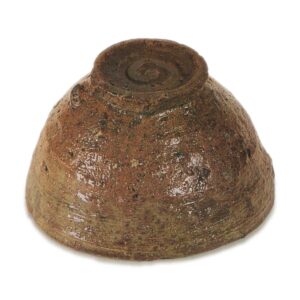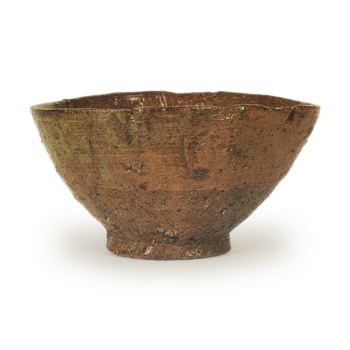

Collection: Fujita Museum of Art
Height: 7.7-8.0cm
Diameter: 13.9-14.9cm
Base diameter: 6.5cm
Height: 0.9cm
The name “Kugibori Iroha” comes from the whorls that look like they have been carved with a nail inside the foot ring, but the style of this work is very different from that of the old Iroha ware. In other words, it is outstanding in terms of strength, and the glaze is particularly profound and mysterious. Some people even praise it as the best of all irabo, and it is not surprising that some people consider it strange.
The main characteristics of Kugibori Iroha are that the rim is not turned up like other pieces, and the rim is beveled. The foot is large, but it is not knotted like a bamboo joint, and inside it is flat, lacking a helmet-shaped cover, and there are folded-over ridges that look as if they were carved with a thick nail, and part of it is a cut foot. In addition, the glaze is generally rough and uneven, which is also a characteristic of this type of ware. The clay is similar to that of Ko-Irabo-suji, but it seems to contain a little more iron, and although it is mixed with sand, it has a lot of stone flecks. The fine lines of the pull marks also stand up sharply inside and out.
The kugibori (nail-engraving) is also thought to have been made at the Shoki Kiln, and even if we consider the kugibori design alone, it is clear that this is a tea bowl with a cut-out shape, just like the Ko-Irabo-suji, and is a Gohon tea bowl. The period is also the same as the Ko-Irabo-suji, and it is probably a generic term for the wide range of Enshu Gohon. There are very few examples of kugibori irabo, and they are as rare as they are numerous. Some of them are thought to have been made by the same artisan, based on the style of the work.
The kugibori irabo in the Fujita Museum is known for the strength of its style, and its sturdy foot ring is reminiscent of a yokozuna sumo wrestler stamping his feet. The natural, attractive shape of the mouth of the mountain path is also a major highlight, as are the two pebbles. The overall shape is accentuated by the large three-tiered cut-out from the hem down to the side of the foot, and the presence of small and large stones on the sides and elsewhere also adds to the strength of the workmanship. The inside and outside of the Irobo glaze is very thin, and generally, the highly lustrous glaze is strongly reddish, and in places, it has a bluish tinge like a persimmon belt. Fine lines of pulling stand inside and outside, and inside the foot ring, a thick, flat nail carving spirals. There are five eyes in the interior.
The accompanying items are
Inner box: Hikiya Karamono Kaikyo Hoko-e
Middle box: Black lacquer
Outer box: Shunkei lacquer
It was passed down through the Matsudaira Shuho family, and later passed to the Kaga Matsutoyo family for a time, before becoming the property of the Fujita family. It is currently in the collection of the Fujita Art Museum.



